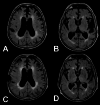Reversal of cerebral pseudoatrophy in normal pressure hydrocephalus after ventriculoatrial shunt placement
- PMID: 40640209
- PMCID: PMC12246446
- DOI: 10.1038/s41598-025-03158-6
Reversal of cerebral pseudoatrophy in normal pressure hydrocephalus after ventriculoatrial shunt placement
Abstract
Normal Pressure Hydrocephalus (NPH) is a syndrome in predominantly older adults, differential diagnoses include primary neurodegenerative diseases. The key radiological finding is ventricular enlargement, different from increased ventricular size associated with cerebral atrophy. After definitive surgical cerebrospinal fluid (CSF) shunting there appears to be increased brain tissue volume in patients' follow-up images which could indicate that imaging findings usually interpreted as cerebral atrophy may be reversible with appropriate treatment. A cross-sectional study was performed comparing pre and postoperative brain volume in magnetic resonance imaging (MRI) studies of NPH patients who underwent ventriculoatrial shunting at our institution between April 2016 and February 2022. Brain volumes were obtained using volBrain and vol2Brain software. 30 patients were included, and 60 MRI studies reviewed. The average age was 80.4 years (54-92 years). 20 patients (66.6%) were men and 10 women. Following CSF shunting, patients had a statistically significant increase in white matter (p = 0.043), gray matter (p = 0.002), and total brain parenchyma (p = 0.032). The brain volume increased in postoperative MRI. We call this finding cerebral pseudoatrophy, which has not been previously described. Further studies are required to confirm this finding, which poses relevance for the accurate diagnosis of NPH.
Keywords: Brain volume; Cerebral pseudoatrophy; Hydrocephalus; Normal pressure hydrocephalus; Ventricles; Ventriculoatrial shunt.
© 2025. The Author(s).
Conflict of interest statement
Declarations. Competing interests: The authors declare no competing interests.
Figures




Similar articles
-
Endoscopic third ventriculostomy (ETV) for idiopathic normal pressure hydrocephalus (iNPH).Cochrane Database Syst Rev. 2015 Jul 29;2015(7):CD010033. doi: 10.1002/14651858.CD010033.pub2. Cochrane Database Syst Rev. 2015. PMID: 26222251 Free PMC article.
-
Repeated lumbar or ventricular punctures in newborns with intraventricular haemorrhage.Cochrane Database Syst Rev. 2017 Apr 6;4(4):CD000216. doi: 10.1002/14651858.CD000216.pub2. Cochrane Database Syst Rev. 2017. PMID: 28384379 Free PMC article.
-
Magnetic resonance perfusion for differentiating low-grade from high-grade gliomas at first presentation.Cochrane Database Syst Rev. 2018 Jan 22;1(1):CD011551. doi: 10.1002/14651858.CD011551.pub2. Cochrane Database Syst Rev. 2018. PMID: 29357120 Free PMC article.
-
Volumetric predictors for shunt-dependency in pediatric posterior fossa tumors.Sci Rep. 2025 Jun 20;15(1):20235. doi: 10.1038/s41598-025-06825-w. Sci Rep. 2025. PMID: 40542153 Free PMC article.
-
[Volume and health outcomes: evidence from systematic reviews and from evaluation of Italian hospital data].Epidemiol Prev. 2013 Mar-Jun;37(2-3 Suppl 2):1-100. Epidemiol Prev. 2013. PMID: 23851286 Italian.
References
-
- Adams, R. D., Fisher, C. M., Hakim, S., Ojemann, R. G. & Sweet, W. H. Symptomatic occult hydrocephalus with normal cerebrospinal-fluid pressure: A treatable syndrome. N. Engl. J. Med.273, 117–126 (1965). - PubMed
-
- Bräutigam, K., Vakis, A. & Tsitsipanis, C. Pathogenesis of idiopathic normal pressure hydrocephalus: A review of knowledge. J. Clin. Neurosci.61, 10–13 (2019). - PubMed
-
- Sundström, N., Lundin, F., Arvidsson, L., Tullberg, M. & Wikkelsø, C. The demography of idiopathic normal pressure hydrocephalus: Data on 3000 consecutive, surgically treated patients and a systematic review of the literature. J. Neurosurg.10.3171/2022.2.JNS212063 (2022). - PubMed
-
- Pyykkö, O. T. et al. Incidence, comorbidities, and mortality in idiopathic normal pressure hydrocephalus. World Neurosurg.112, e624–e631 (2018). - PubMed
-
- Gallia, G. L., Rigamonti, D. & Williams, M. A. The diagnosis and treatment of idiopathic normal pressure hydrocephalus. Nat. Clin. Pract. Neurol.2, 375–381 (2006). - PubMed
MeSH terms
Grants and funding
LinkOut - more resources
Full Text Sources
Miscellaneous

